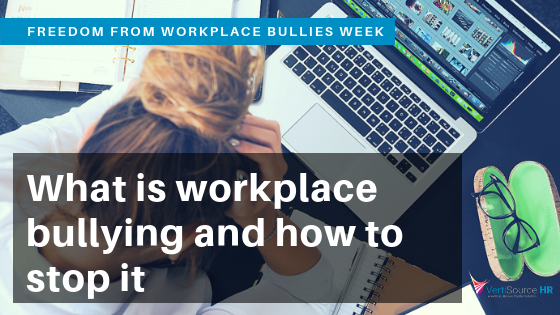Freedom From Workplace Bullies Week is commemorated on October 14th through October 20th this year. Awareness of this issue during this special week is a chance to break through the shame and silence surrounding bullying. It is a time to be bold and shut down the power of bullying and its ability to stay hidden in plain sight.
During Freedom From Workplace Bullies Week, it’s important to understand all instances of bullying in the workplace are not always clearly addressed in employee handbooks. However, it has become a national issue, as about 27% of adult Americans have experienced abusive conduct at work. According to the healthyworkplacebill.org, workplace bullying is defined as “ repeated, health-harming mistreatment of one or more persons (the targets) by one or more perpetrators.” This kind of abusive conduct can take a number of forms, most commonly verbal abuse, threatening, intimidating or humiliating behaviors (including nonverbal), or work interference, like sabotage, which prevents work from getting done.
Although workplace bullying is a non-physical, non-homicidal form of violence, it can still cause substantial harm, causing both emotional and stress-related physical harm. Part of the reason for Freedom From Workplace Bullies Week is to create awareness of the harm it can cause such as stress. Stress is not be taken lightly as the effects of stress on the body can be substantial. “Stress is the biological human response to stressors. It is physiological and real, not just imagined,” according to workplacebullying.org. Furthermore, distress is also a harmful variety of stress, triggering an automatically coordinated release of glucocorticoids, cortisol being the most prominent hormone, that floods the brain and body. Prolonged exposure of brain tissue glucocorticoids leads to atrophy of areas responsible for memory, emotional regulation and an ability to sustain positive social relationships. At its most severe, it can trigger stress-related health complications such as hypertension, autoimmune disorders, depression, anxiety to PTSD.
Bullying and abusive behavior in the workplace can potentially lead to these types of complication. Not only that, but the person’s immediate job and career are now disrupted.
What is being done?
Given that there are six candidates for each job opening in the United States, employees are more apt to stay in a miserable work environment and will put up with stress-related health complications as well.
However, some employers are realizing that putting a stop to bullying in the workplace is good for business. According to healthyworkplacebill.org, “Sioux City Iowa is the first school district in the nation to address workplace bullying for their adult employees. They have voluntarily created policies and credible enforcement procedures to purge destructive individuals.”
American unions have also begun to take the first steps towards ending bullying. Some have conducted training to provide peer support for their bullied members. “Bullying is a vexing problem for most unions when the mistreatment is member-on-member.” These few examples are a step in the right direction, however, there is still so much more that needs to be done.
WBI Healthy Workplace Bill
Because employers react to laws with internal policies, the WBI Healthy Workplace Bill is a valuable Bill which gets employers to prevent bullying with policies and producers that apply to all their employees.“The Bill, crafted by law professor David Yamada for the Healthy Workplace Campaign, gives good employers incentives to do the right thing by avoiding expensive litigation.”
While some may question why a law need be in place, according to the WBI 2014 U.S. Workplace Bullying Survey results, “employers deny that bullying happens, or discount its destructive power if admitted to or rationalize the positive benefits of bullying.” This shows that often when there isn’t external pressure to do the right thing for workers, most employers won’t.
By precisely defining “abusive work environment” for employers, it sets a higher standard for misconduct and also protects them from vicarious liability risk when internal correction and prevention mechanisms are in effect. This Bill will give employers a clear-cut reason to terminate or sanction an offender and plugs the gaps in the current state and federal civil rights protections.
For employees, the WBI Healthy Workplace Bill provides an avenue for legal action for cruelty at work. It will also allow a worker to sue their bully and hold their employers accountable, which in turn compels employers to prevent or correct future misconduct from happening.
What you can do on your own
The Workplace Bullying Institute has created a three-step target action plan to help individuals experiencing a workplace bullying situation. To summarize, Step One involves naming what is happening to you as bullying. There is power in naming your abuse as it legitimizes it.
For Step Two, they suggest taking time off to heal from the stress as it takes such a toll on your mental and physical health. Work with a professional or check in with your doctor if you feel you need to. Also, take this time to research legal options of laws against bullying in your state. Knowledge is power. Perhaps even start searching for a new job during this time of rest.
For Step Three, expose your bully. “The real risk was sustained when you were first targeted (Targets lose their job – involuntarily or by choice for their health’s sake – in 77.7% of cases). It is no riskier to attempt to dislodge the bully. Retaliation is a certainty. Have your escape route planned in advance. Remember, good employers purge bullies, most promote them.” Stick to the bottom line of the situation and remember that your health and wellbeing is the most important factor.
For more information on this three-step action plan, click here!
For additional reading on employee wellness and what you can do, read our post, “What You Should Know About Wellness Programs for Employees”.



